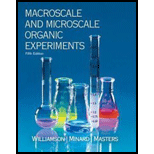Sorry! We don’t have solutions for this edition yet.
Solutions are available for other editions of this book
View 7th Edition solutionsarrow_forwardBook Details
The market leader for the full-year organic laboratory, this manual derives many experiments and procedures from the classic Feiser lab text, giving it an unsurpassed reputation for solid, authoritative content. The Williamson/Minard/Masters manual's flexible mix of macroscale and microscale options for most experiments allows instructors to save on the purchase and disposal of expensive, sometimes hazardous organic chemicals. Macroscale versions can be used for less costly experiments, giving students experience working with conventionally sized glassware.
The Fifth Edition of the manual includes new experiments that stress greener chemistry, revised content in computational chemistry, and more information on laboratory safety procedures.
- New! Experiments that stress greener chemistry appear throughout the manual and are identified with a green chemistry icon. For example, the use of household bleach is explored as an alternative to the toxic chromium ion as an oxidizing agent for cyclohexanol.
- New! The laboratory safety chapter now includes material on working with closed systems and laboratory courtesy.
- New! The chapter on mass spectrometry describes time-of-flight and mass quadrupole analyzers, and includes sections on GC-MS and computer-aided spectral identification as well as ESI and MALDI ionization.
- New! Bioassay experiments include a bioassay of eugenol isolated from cloves.
- New! Material is now offered on diffuse reflectance IR analysis, capillary GC, and temperature programming.
- Revised! The place of organic chemistry labwork has been put in a broader context via reorganization of and revisions to the first fifteen chapters dealing with basic lab methods, computational chemistry, and instrumental methods.
- Revised! Computational chemistry, which allows students to determine the precise structure of molecules, has been extensively revised to provide extended coverage of ab initio and semi-empirical models and calculations.
- Revised! The discussions of NMR theory and the interpretation of 1HNMR spectra have been updated.
- The In this experiment... section appears before selected microscale experiments and presents the overarching objective of the experiment, keeping students from getting bogged down in the details of experimental procedures.
- For Further Investigation procedures appear in selected experiments. These are optional, additional procedures that can be assigned to further explore the chemical principle being presented.
- A Cleaning Up section appears at the end of every experiment and instructs students on how to dispose of all the by-products used in the experiment. Other pedagogical features include pre-lab exercises, marginal notes, clear line drawings, and end-of-chapter questions.
More Editions of This Book
Corresponding editions of this textbook are also available below:
